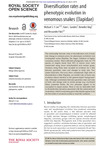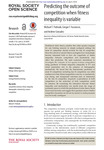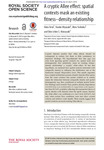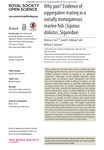Education: Recent submissions
Now showing items 41-60 of 806
-
Social signals and algorithmic trading of Bitcoin
(2015)The availability of data on digital traces is growing to unprecedented sizes, but inferring actionable knowledge from large-scale data is far from being trivial. This is especially important for computational finance, where ... -
Use of elastic stability analysis to explain the stress-dependent nature of soil strength
(2015)The peak and critical state strengths of sands are linearly related to the stress level, just as the frictional resistance to sliding along an interface is related to the normal force. The analogy with frictional sliding ... -
Izumo1 and Juno
(2015)Reproductive proteins are among the most rapidly evolving classes of proteins. For a subset of these, rapid evolution is driven by positive Darwinian selection despite vital, well-conserved, reproductive functions. Izumo1 ... -
Diversification rates and phenotypic evolution in venomous snakes
(2016)The relationship between rates of diversification and of body size change (a common proxy for phenotypic evolution) was investigated across Elapidae, the largest radiation of highly venomous snakes. Time-calibrated ... -
Predicting the outcome of competitionwhen fitness inequality is variable
(2015)Traditional niche theory predicts that when species compete for one limiting resource in simple ecological settings the more fit competitor should exclude the less fit competitor. Since the advent of neutral theory ecologists ... -
The advantage of short paper titles
(2015)Vast numbers of scientific articles are published each year, some of which attract considerable attention, and some of which go almost unnoticed. Here, we investigate whether any of this variance can be explained by a ... -
Can outcomes of dyadic interactions be consistent across contexts among wil zebrafish?
(2015)Winner–loser relations among group-living individuals are often measured by the levels of aggressive interactions between them. These interactions are typically driven by competition for resources such as food and mates. ... -
Shared Escovopsis parasites between leaf cutting and non leaf cutting ants in the higher attine fungus growing ant symbiosis
(2015)Fungus-gardening (attine) ants grow fungus for food in protected gardens, which contain beneficial, auxiliary microbes, but also microbes harmful to gardens. Among these potentially pathogenic microorganisms, the most ... -
A cryptic Allee effect
(2015)Current theories predict that Allee effects should be widespread in nature, but there is little consistency in empirical findings. We hypothesized that this gap can arise from ignoring spatial contexts (i.e. spatial scale ... -
Comparing maternal genetic variation across two millennia reveals the demographic history of an ancient human population in southwest Turkey
(2016)More than two decades of archaeological research at the site of Sagalassos, in southwest Turkey, resulted in the study of the former urban settlement in all its features. Originally settled in late Classical/early Hellenistic ... -
Why pair? Evidence of aggregative mating in a socially monogamous marine fish
(2015)Many species live in stable pairs, usually to breed and raise offspring together, but this cannot be assumed. Establishing whether pairing is based on mating, or an alternative cooperative advantage, can be difficult, ... -
Efficient conformational space exploration in ab initioprotein folding simulation
(2015)Ab initio protein folding simulation largely depends on knowledge-based energy functions that are derived from known protein structures using statistical methods. These knowledge-based energy functions provide us with a ... -
A counterview of ‘An investigation of the false discovery rate and the misinterpretation of p-values’ by Colquhoun
(2015)In commenting on the instructive, comprehensive and entertainingly written article by Prof. Colquhoun (hereinafter referred to as ‘the author’), we state unequivocally that we have no truck with its motivation. Indeed, we ... -
The presence of lateral photophores correlates with increased speciation in deep-sea bioluminescent sharks
(2015)The vast majority of species within the lanternshark genus Etmopterusharbour complex luminescent markings on their flanks, whose functional significance has long remained obscure. Recent studies, however, suggest these ... -
Unexpected consequences of a drier world
(2015)The complexity of animal life histories makes it difficult to predict the consequences of climate change on their populations. In this paper, we show, for the first time, that longer summer drought episodes, such as those ... -
To what extent do human-altered landscapes retain population connectivity?
(2015)Understanding how human-altered landscapes affect popula-tion connectivity is valuable for conservation planning. Natural connectivity among wetlands, which is maintained by floods, is disappearing owing to farmland ... -
Relationships within Cladobranchia based on RNA-Seq data
(2015)Cladobranchia (Gastropoda: Nudibranchia) is a diverse (approx. 1000 species) but understudied group of sea slug molluscs. In order to fully comprehend the diversity of nudibranchs and the evolution of character traits ... -
Untitled
(2015)Since the Mid-Holocene, some 5000 years ago, coral reefs in the Pacific Ocean have been vertically constrained by sea level. Contemporary sea-level rise is releasing these constraints, providing accommodation space for ... -
Evolutionary origins and development of saw-teeth on the sawfish and sawshark rostrum
(2015)A well-known characteristic of chondrichthyans (e.g. sharks, rays) is their covering of external skin denticles (placoid scales), but less well understood is the wide morphological diversity that these skin denticles can ... -
Symbiotic bacteria enable olive fly larvae to overcome host defences
(2015)Ripe fruit offer readily available nutrients for many animals, including fruit fly larvae (Diptera: Tephritidae) and their associated rot-inducing bacteria. Yet, during most of their ontogeny, fruit remain chemically ...




















